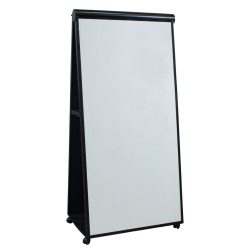Chalk boards at meetings are a thing of the past. White boards and glass marker boards are now what’s being used in meetings and for presentations. They can be used in the same fashion that a chalk was used but without the hazard of breathing chalk dust. Too, there are different types of whiteboards and glass marker boards. This makes it easy to find one which will suit your office needs.
Types of whiteboard
There are different types of whiteboards for use in your office or conference room. Listed below are some of the different kinds of whiteboards and options:
 Melamine or plastic whiteboards: This whiteboard has a non-magnetic surface or you can have a choice of a steel backing which will let it accept magnets. If you want a whiteboard which is budget friendly, then this is the perfect board for your budget. Melamine is easy to mount because it’s also lightweight.
Melamine or plastic whiteboards: This whiteboard has a non-magnetic surface or you can have a choice of a steel backing which will let it accept magnets. If you want a whiteboard which is budget friendly, then this is the perfect board for your budget. Melamine is easy to mount because it’s also lightweight.- Porcelain or ceramic whiteboards: This is a more expensive option but it has a more durability. It also has a high resistance to stains and scratches. The porcelain boards have an easy writing surface and most of the time magnetic. Another good point is that it doesn’t “ghost” which is when marker stains are left that can’t be wiped off. Porcelain is heavier, although easier to clean and more durable than melamine, so it may take at least two people to mount it.
- Glass whiteboards: This type of whiteboard isn’t porous at all. So, you won’t have staining or unwanted ghosting at all on a glass whiteboard. Markers will erase with smudges easily and lasts a long time. The glass whiteboards can reflect a double image if magnetic and if the lighting is poor, which could make them difficult to read sometimes Another point is that glass whiteboards don’t have a frame, so it has a modern eye-catching appearance.
Where will the whiteboard be placed?
 When purchasing a whiteboard, keep in mind what room you’re going to be using it in. Also, what the whiteboards intended purpose will be. If it’s used in a conference room where it may be used also as a projection screen, you’ll need a board with a matte finish.
When purchasing a whiteboard, keep in mind what room you’re going to be using it in. Also, what the whiteboards intended purpose will be. If it’s used in a conference room where it may be used also as a projection screen, you’ll need a board with a matte finish.
If a whiteboard has too high of a gloss finish, it will produce a glare which will make it hard to read from. If training sessions is what its purpose it, then you’ll need an interactive board. A board which is interactive integrates your computer and your projector onto your whiteboard. This grabs and helps to retain the attention of your employees and makes a better learning experience.
If the whiteboard is going into your executive office, then you may want to look at an enclosed whiteboard. These come in cabinet form so it can be concealed when it’s not being used, keeping the professional appearance of your office intact. The side of this type of whiteboard also has additional whiteboard space, or a corkboard, so you can keep memos on it and post notes.
Wall mounted or free-standing whiteboard
You also have to decide whether you want your whiteboard to remain stationary at all times in one room. Or perhaps instead, one that’s mobile which can be transported wherever you need it. The benefits of a wall mounted whiteboard come in either a frameless or framed version. The framed version either comes in a metal frame or it can come in wood and be matched to the furniture in the office. If it’s mounted, then your board is where you want it to be.
But, if you prefer to move your whiteboard wherever you’re going to be, then you might like the mobile option. This option can be moved from room to room, so you won’t need one in every room there’s a meeting or a program. It can also be used as a room divider or a partition and it adjusts to the height which is needed.
Different whiteboards work for different offices; you have to decide which one works for you.
References:
https://nationalofficeinteriors.com/product-category/accessories/white-boards/
http://www.meetingsimagined.com/tips-trends/3-ways-use-dry-erase-board




